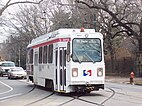SEPTA Metro is an urban rail transit network in and around Philadelphia, Pennsylvania, United States, operated by the Southeastern Pennsylvania Transportation Authority (SEPTA). The network includes two rapid transit lines, a light metro line, a surface-running trolley line, and a subway–surface trolley line, totaling 78 miles (126 km)[b] of rail service.
Although some of Philadelphia's transit lines date to the 19th century and the SEPTA agency began operations in 1965, the transit network itself had no formal name until 2024, when it was named "SEPTA Metro" as part of an effort to make the system easier to navigate. The effort is also replacing each line's name with a single letter, plus a number to denote various service patterns. After a two-year transition that will replace signage throughout the system, the Market–Frankford Line, Broad Street Line, subway–surface trolley lines, Route 15 trolley, Media–Sharon Hill Line, and Norristown High Speed Line will be referred to as the L, B, T, G, D, and M, respectively.
Cite error: There are <ref group=lower-alpha> tags or {{efn}} templates on this page, but the references will not show without a {{reflist|group=lower-alpha}} template or {{notelist}} template (see the help page).
- ^ "Route Operating Statistics". Retrieved September 15, 2024.
- ^ "SEPTA Operating Facts: Fiscal Year 2019" (PDF). SEPTA. 2019. p. 5. Archived (PDF) from the original on May 4, 2024. Retrieved July 15, 2024.






